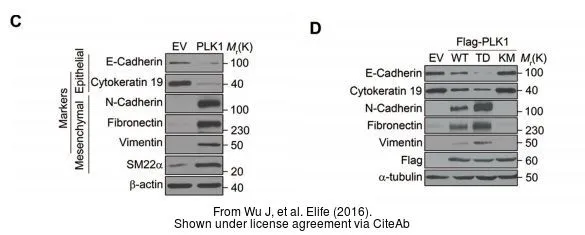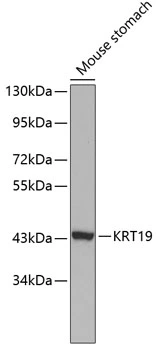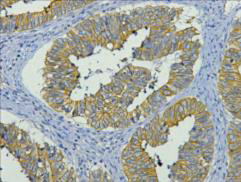![WB analysis of MCF-7 cell lysate using GTX27754 Cytokeratin 19 antibody [A53-B/A2]. Lane 1,2 : GTX27755 Lane 3,4 : GTX27754 WB analysis of MCF-7 cell lysate using GTX27754 Cytokeratin 19 antibody [A53-B/A2]. Lane 1,2 : GTX27755 Lane 3,4 : GTX27754](https://www.genetex.com/upload/website/prouct_img/normal/GTX27754/GTX27754_20191028_WB_1_w_23060722_247.webp)
WB analysis of MCF-7 cell lysate using GTX27754 Cytokeratin 19 antibody [A53-B/A2]. Lane 1,2 : GTX27755 Lane 3,4 : GTX27754
Cytokeratin 19 antibody [A53-B/A2]
GTX27754
ApplicationsFlow Cytometry, ImmunoFluorescence, ImmunoPrecipitation, Western Blot, ELISA, ImmunoCytoChemistry, ImmunoHistoChemistry, ImmunoHistoChemistry Paraffin
Product group Antibodies
TargetKRT19
Overview
- SupplierGeneTex
- Product NameCytokeratin 19 antibody [A53-B/A2]
- Delivery Days Customer9
- ApplicationsFlow Cytometry, ImmunoFluorescence, ImmunoPrecipitation, Western Blot, ELISA, ImmunoCytoChemistry, ImmunoHistoChemistry, ImmunoHistoChemistry Paraffin
- CertificationResearch Use Only
- ClonalityMonoclonal
- Clone IDA53-B/A2
- Concentration1 mg/ml
- ConjugateUnconjugated
- Gene ID3880
- Target nameKRT19
- Target descriptionkeratin 19
- Target synonyms40-kDa keratin intermediate filament; CK19; CK-19; cytokeratin 19; K19; K1CS; keratin 19, type I; keratin, type I cytoskeletal 19; keratin, type I, 40-kd
- HostMouse
- IsotypeIgG2a
- Protein IDP08727
- Protein NameKeratin, type I cytoskeletal 19
- Scientific DescriptionThe protein encoded by this gene is a member of the keratin family. The keratins are intermediate filament proteins responsible for the structural integrity of epithelial cells and are subdivided into cytokeratins and hair keratins. The type I cytokeratins consist of acidic proteins which are arranged in pairs of heterotypic keratin chains. Unlike its related family members, this smallest known acidic cytokeratin is not paired with a basic cytokeratin in epithelial cells. It is specifically expressed in the periderm, the transiently superficial layer that envelopes the developing epidermis. The type I cytokeratins are clustered in a region of chromosome 17q12-q21. [provided by RefSeq, Jul 2008]
- Storage Instruction2°C to 8°C
- UNSPSC12352203
References
- Polo-like kinase 1 induces epithelial-to-mesenchymal transition and promotes epithelial cell motility by activating CRAF/ERK signaling. Wu J et al., 2016 Mar 22, ElifeRead more


![FACS analysis of MeOH-fixed MCF-7 cells using GTX34649 Cytokeratin 19 antibody [SPM561]. Blue : Primary antibody Red : Isotype control](https://www.genetex.com/upload/website/prouct_img/normal/GTX34649/GTX34649_20200115_FACS_1598_w_23051500_477.webp)



![WB analysis of MCF-7 cell lysates using GTX80226 Cytokeratin 19 antibody [BA-17] (Biotin).](https://www.genetex.com/upload/website/prouct_img/normal/GTX80226/GTX80226_20191028_WB_1_w_23061322_765.webp)